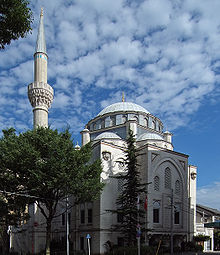Tokyo Mosque


Tokyo Camii, Tōkyō-jāmii (東京ジャーミイ) also known as Tokyo Mosque, is a mosque with an adjoining Turkish culture center located in the Ōyama-chō district of Shibuya ward in Tokyo, Japan. It is the largest mosque in Japan. The mosque was originally built along with an adjoining school on May 12, 1938 by Bashkir and Tatar immigrants from Russia who had come to Japan after the October Revolution. It was made under the direction of Abdürreşid İbrahim, the first Imam of the mosque, and Abdülhay Kurban Ali.
In 1986, the mosque had to be demolished because of severe structural damage. Under the direction and support of Diyanet İşleri Başkanlığı a new building was begun in 1998. The architect for the building was Muharrem Hilmi Senalp. The ornamentation was based on Ottoman religious architecture. Around 70 Turkish craftsmen performed the finishing details, and a considerable quantity of marble was imported from Turkey. The construction was completed in 2000 at a cost of around 1.5 billion yen. The inauguration was held on June 30, 2000.[1]
Tokyo Camii is 734 square meters in area and has one basement floor and three above-ground floors with a total floor area of 1,477 square meters. Its main dome is 23.25 meters tall and is supported by six pillars, while the adjacent minaret is 41.48 meters tall.[2]
Notes
The word camii is a Turkish word derived from the Arabic word jami which means 'congregational mosque.'
See also
- Annur Mosque, Niigata
- Fukuoka Mosque
- Kobe Mosque
- Islam
- Islam in Japan
- List of mosques in Asia
- Religion in Japan
References
- ^ “New Tokyo Mosque opens”, in: The Japan Times, July 1st, 2000.
- ^ “Japan's largest mosque completed in Tokyo”, in: Kajima News & Notes, Autumn 2000.
External links
- Official Website - Japanese and English
- Information about the building - Japanese

